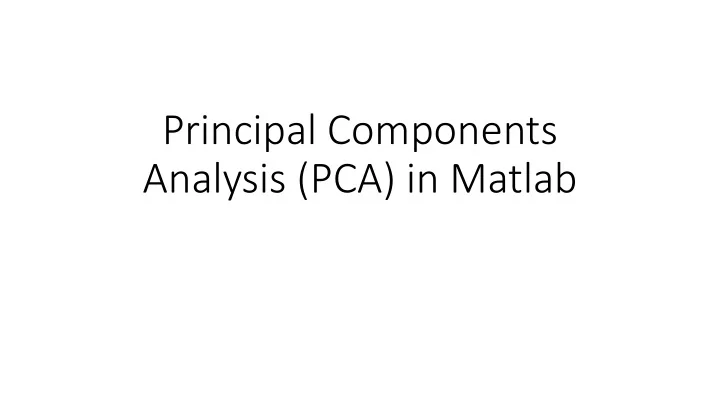

Principal Components Analysis (PCA) in Matlab
Princi cipal C Compon onen ents An Analysis i in Matlab [coeff,score,latent,tsquared,explained] = pca(X) • X: input data • Matrix with n rows and p columns • Each row is an observation or sample • Each column is a predictor variable • All columns must be zero-centered X(:,i) = X(:,i) – mean(X(:,i)) • pca will zero-center automatically, but any reconstructed output will not match X • Recommended that you scale the variance of columns to 1 by converting X to Z-scores [...] = pca(zscore(X))
Princi cipal C Compon onen ents An Analysis i in Matlab [coeff,score,latent,tsquared,explained] = pca(X) • co coef eff: coefficients (loadings) for each PC • Square pxp matrix • Each column is a principal component • Each entry -- coeff(i,j) -- is the loading of variable i in principal component j • The matrix is orthonormal and each column is a right singular vector of X; coeff ff is the matrix V from the SVD of X. • The first column explains the most variance. The variance explained by each subsequent column decreases.
Princi cipal C Compon onen ents An Analysis i in Matlab [coeff,score,latent,tsquared,explained] = pca(X) • sco score re: Data (X) transformed into PC space • Rectangular nxp matrix • Each row corresponds to a row in the original data matrix X. • Each column corresponds to a principal component. • If row i in X was decomposed over the principal component vectors, the coefficients would be score(i,j): X(i,:) = score(i,1)*coeff(:,1) + score(i,2)*coeff(:,2) + ... + score(i,p)*coeff(:,p)
Princi cipal C Compon onen ents An Analysis i in Matlab [coeff,score,latent,tsquared,explained] = pca(X) • latent nt: Variance explained by each PC • ex explained ed: % of total variance explained by each PC • Both latent and explaine ned are vectors of length p (one entry for each PC • explained = latent/sum(latent) * 100 • Variance explained is used when deciding how many PCs to keep.
Princi cipal C Compon onen ents An Analysis i in Matlab [coeff,score,latent,tsquared,explained] = pca(X) • tsquared red: Hotelling’s T-squared statistic • Vector of length n , one entry for every observation in X. • Statistic measuring how far each observation is from the “center” of the entire dataset. • Useful for identifying outliers.
Standar dard P PCA Workf kflow 1. Make sure data are rows=observations and columns=variables. 2. Convert columns to Z-scores. (optional, but recommended) 3. Run [coeff,score,latent,tsquared,explained] = pca(X) 4. Using the %variance in “explained”, choose k = 1, 2, or 3 components for visual analysis. 5. Plot score(:,1), ..., score(:,k) on a k-dimensional plot to look for clustering along the principal components. 6. If clustering occurs along principal component j, look at the loadings coeff(:,j) to determine which variables explain the clustering.
Example: le: F Fluor oride e e effects ts o on the M e Microbiom iome 1. Study examined mice given no, low, or high levels of fluoride in drinking water for 12 weeks. 2. Microbiome samples taken from mouth and stool were sequenced to identify changes in microbial composition. 3. Variables are the abundances of species in the samples (called OTUs, or operational taxonomic units). ~10,000-30,000 OTUs are commonly seen in human microbiome samples. 4. Source: Yasuda K, et al. 2017. Fluoride depletes acidogenic taxa in oral but not gut microbial communities in mice. mSystems 2: e00047-17. https://doi.org/10.1128/mSystems.00047-17.
Result 1 1: Little v variation b between oral a and stool samples 1. First two PCs explain 35.3 + 12.2 = 47.5% of the total variance in the dataset. 2. PC1 does not separate the oral and stool samples. 3. PC2 does, however PC2 explains only 12.2% of the total variation. 4. The variables loaded in PC2 explain differences between the samples, but the total effect is not large. 5. In fact, the separation is only visible after the effects of PC1 were factored out.
Result 2 2: Fluoride ch changes oral m micr crobiome c composition 1. PCs 1&3 explain 67.3 + 5.3 = 72.3% of the total variance in the dataset. 2. PC1 & PC2 do not separate the samples by fluoride levels. 3. PC3 does, however PC2 explains only 5.3% of the total variation. 4. The variables loaded in PC3 explain differences between fluoride levels, but the total effect is not large; the effects of PC1 must be removed first. 5. The authors confirmed several of the species loaded onto PC3 were affected by fluoride levels.
Result 3: F Fluoride ch changes a are l limited t to t the oral cavi vity 1. Neither PC1 or PC2 separate the stool microbiome samples by fluoride levels. 2. Since these PCs explain 85.1 + 3.6 = 88.7% of the total variation, any effects of fluoride on the stool microbiome must be very small.
Recommend
More recommend